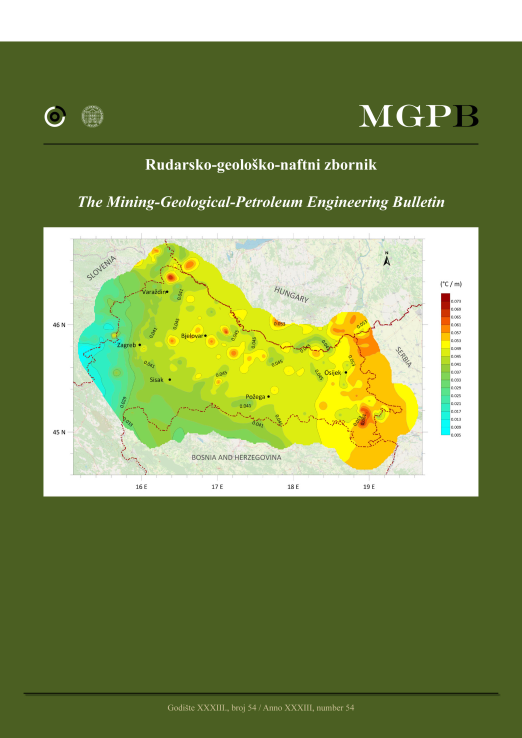Numerical Investigation of Fluid Flow Instabilities in Pore-scale with Heterogeneities in Permeability and Wettability
DOI:
https://doi.org/10.17794/rgn.2021.3.10Keywords:
quadrant geometry, wettability and permeability, heterogeneities, nodal effects, Lattice Boltzmann methodAbstract
Quadrant geometry with permeability and wettability contrast occurs in different events, such as faults, wellbore damage, and perforation zones. In these events, understanding the dynamics of immiscible fluid displacement is vital for enhanced oil recovery. Fluid flow studies showed that viscous fingering occurs due to viscous instabilities that depend on the mobility of fluids and capillary forces. Besides, the porous domain heterogeneity is also effective on the formation of fingering. So, the purpose of the current research is to numerically investigate the effect of heterogeneity in wettability and permeability, and flow properties in Saffmann-Taylor instabilities. Numerical simulations with different flow rates in the permeability contrast model illustrated the nodal crossflow, growth of viscous fingering in the nodal part, and bypass flow in the second zone. In the wettability contrast model, a capillary fingering pattern is observed and fluid patches are isolated because of capillary force and the end effects are trapped within the quadrant. Moreover, the consequences of wettability on apparent wettability that alters the fluid-front pattern and displacement efficiency are shown.
Downloads
Published
How to Cite
Issue
Section
License
Copyright (c) 2021 authors and journal

This work is licensed under a Creative Commons Attribution 4.0 International License.
Creative Commons-BY
Authors who publish with this journal agree to the following terms:
In agreeing this form, you certify that:
- You read the ethical codex of the RGN zbornik available at journal web.
- You submitted work is your original work, and has not previously been published and does not include any form of plagiarism.
- You own copyright in the submitted work, and are therefore permitted to assign the licence to publish to RGN zbornik.
- Your submitted work contains no violation of any existing copyright or other third party right or any material of an obscene, libellous or otherwise unlawful nature.
- You have obtained permission for and acknowledged the source of any illustrations, diagrams or other material included in the work of which you are not the copyright owner.
- You have taken due care to ensure the accuracy of the work, and that, to the best of your knowledge, there are no false statements made within it.
- All co-authors of this submitted work are aware of, and in agreement with, the terms of this licence and that the submitted manuscript has been approved by these authors.
Publication licence
You retain copyright in your submitted work, according to journal license policy (CC-BY). By signing this form you agree that RGN zbornik may publish it under the publication licence. In summary the licence allows the following:
Anyone is free:
- To copy, distribute, display, and perform the work.
- To make derivative works.
Under the following conditions:
- The original author must always be given credit.
- The work may not be used for commercial purposes.
- If the work is altered, transformed, or built upon, the resulting work may only be distributed under a licence identical to this one.
Exceptions to the licence
In addition to publishing the work printed under the above licence, RGN zbornik will also enable the work to be visible online.
The journal editorial can change the licence rules anytime but it cannot retroactively restrict author(s) rights.


